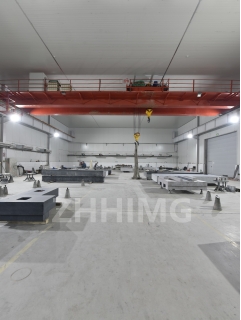Precision granite pedestal bases are often used in a variety of industrial settings for their extreme durability, accuracy, and stability. These bases are typically made from high-quality granite that has been expertly machined and polished to provide an ideal surface for a wide range of applications. There are a number of distinct advantages and disadvantages to using precision granite pedestal bases, and it is important to consider both before making a decision.
Advantages:
1. Extremely Accurate: One of the biggest advantages of precision granite pedestal bases is that they are incredibly accurate. The granite material used in these bases has been carefully selected and machined to an exacting standard, providing a stable and level surface that can be relied upon for highly precise measurements.
2. Durable and Long-Lasting: Another key advantage of granite pedestal bases is their durability. Granite is an incredibly hard and durable material that can withstand extreme temperatures and pressures, as well as resist corrosion and wear. As a result, these bases are able to provide reliable service for many years, even in harsh industrial environments.
3. Resistant to Vibration: Granite is also a highly stable material that is resistant to vibration. This means that precision components and instruments can be mounted onto the base without worrying about any vibrations that may disturb their accuracy. This makes granite pedestal bases ideal for use in applications where precision is essential, such as in the aerospace or automotive industries.
4. Non-Magnetic: One more advantage of granite pedestal bases is that they are non-magnetic. This means that they will not interfere with any magnetic sensors or instruments that may be present in the surrounding environment. This property makes them ideal for use in industries such as electronics or telecommunications where electromagnetic interference must be avoided.
Disadvantages:
1. Heavy: One of the biggest disadvantages of granite pedestal bases is that they are heavy. Due to the density of the granite material used, these bases can be difficult to move and position. Additionally, their weight can limit the size and mobility of the instruments that can be mounted on them.
2. High Initial Cost: Another potential drawback of granite pedestal bases is their high initial cost. These bases are typically more expensive than many other types of mounting systems, and their cost can be prohibitive for some applications. However, the long lifespan and durability of these bases can ultimately make the investment worthwhile over time.
3. Difficult to Modify: Granite pedestal bases are difficult to modify once they have been machined and polished. This means that any changes or adjustments to the base must be carefully planned and executed, which can be time-consuming and costly.
4. Limited Color Options: Finally, granite pedestal bases are typically only available in a limited range of colors and finishes. While some manufacturers offer a variety of options, others may only provide a standard finish that may not be suitable for all applications.
In conclusion, precision granite pedestal bases offer a number of distinct advantages for industrial applications, including accuracy, durability, stability, and resistance to vibration and electromagnetic interference. However, they also have a few disadvantages, such as their weight, high initial cost, limited flexibility, and limited color options. Ultimately, the decision to use a granite pedestal base will depend on the specific needs of the application and the resources available to support it.
Post time: Jan-23-2024

